Quantitative Assessment of Cropland Exposure to Agricultural Drought in the Greater Mekong Subregion
Abstract
1. Introduction
2. Materials and Methods
2.1. Study Area
2.2. Materials
2.2.1. ESACCI SM
2.2.2. Auxiliary Data
2.2.3. Ground-Based Observation Data
2.3. Methods
2.3.1. Data Processing
2.3.2. Calculation of SSMI and SPEI
2.3.3. Drought Events Identification Based on a 3D Method
2.3.4. Cropland’s Exposure to Agricultural Droughts
3. Results
3.1. SM Data Reconstruction and Validation
3.2. Agricultural Drought Identification Based on 3D Method
3.3. Cropland’s Exposure to Drought Events
4. Discussion
5. Conclusions
Supplementary Materials
Author Contributions
Funding
Data Availability Statement
Acknowledgments
Conflicts of Interest
References
- Kang, H.Y.W.; Sridhar, V.; Ali, S.A. Climate change impacts on conventional and flash droughts in the Mekong River Basin. Sci. Total Environ. 2022, 838, 23. [Google Scholar] [CrossRef] [PubMed]
- Zhang, X.; Hao, Z.C.; Singh, V.P.; Zhang, Y.; Feng, S.F.; Xu, Y.; Hao, F.H. Drought propagation under global warming: Characteristics, approaches, processes, and controlling factors. Sci. Total Environ. 2022, 838, 19. [Google Scholar] [CrossRef] [PubMed]
- Vicente-Serrano, S.M.; Quiring, S.M.; Pena-Gallardo, M.; Yuan, S.S.; Dominguez-Castro, F. A review of environmental droughts: Increased risk under global warming? Earth-Sci. Rev. 2020, 201, 23. [Google Scholar] [CrossRef]
- Mishra, A.K.; Singh, V.P. A review of drought concepts. J. Hydrol. 2010, 391, 204–216. [Google Scholar] [CrossRef]
- Carrao, H.; Russo, S.; Sepulcre-Canto, G.; Barbosa, P. An empirical standardized soil moisture index for agricultural drought assessment from remotely sensed data. Int. J. Appl. Earth Obs. Geoinf. 2016, 48, 74–84. [Google Scholar] [CrossRef]
- Mao, Y.; Wu, Z.Y.; He, H.; Lu, G.H.; Xu, H.T.; Lin, Q.X. Spatio-temporal analysis of drought in a typical plain region based on the soil moisture anomaly percentage index. Sci. Total Environ. 2017, 576, 752–765. [Google Scholar] [CrossRef]
- Feng, P.Y.; Wang, B.; Liu, D.L.; Yu, Q. Machine learning-based integration of remotely-sensed drought factors can improve the estimation of agricultural drought in South-Eastern Australia. Agric. Syst. 2019, 173, 303–316. [Google Scholar] [CrossRef]
- Han, Z.M.; Huang, Q.; Huang, S.Z.; Leng, G.Y.; Bai, Q.J.; Liang, H.; Wang, L.; Zhao, J.; Fang, W. Spatial-temporal dynamics of agricultural drought in the Loess Plateau under a changing environment: Characteristics and potential influencing factors. Agric. Water Manag. 2021, 244, 12. [Google Scholar] [CrossRef]
- Chen, X.G.; Li, Y.; Yao, N.; Liu, D.L.; Javed, T.; Liu, C.C.; Liu, F.G. Impacts of multi-timescale SPEI and SMDI variations on winter wheat yields. Agric. Syst. 2020, 185, 14. [Google Scholar] [CrossRef]
- Crow, W.T.; Berg, A.A.; Cosh, M.H.; Loew, A.; Mohanty, B.P.; Panciera, R.; de Rosnay, P.; Ryu, D.; Walker, J.P. Upscaling Sparse Ground-Based Soil Moisture Observations For The Validation Of Coarse-Resolution Satellite Soil Moisture Products. Rev. Geophys. 2012, 50, 20. [Google Scholar] [CrossRef]
- Modanesi, S.; Massari, C.; Camici, S.; Brocca, L.; Amarnath, G. Do Satellite Surface Soil Moisture Observations Better Retain Information About Crop-Yield Variability in Drought Conditions? Water Resour. Res. 2020, 56, 19. [Google Scholar] [CrossRef]
- Zhao, W.; Sanchez, N.; Lu, H.; Li, A.N. A spatial downscaling approach for the SMAP passive surface soil moisture product using random forest regression. J. Hydrol. 2018, 563, 1009–1024. [Google Scholar] [CrossRef]
- Xu, M.Y.; Yao, N.; Yang, H.X.; Xu, J.; Hu, A.N.; de Goncalves, L.G.G.; Liu, G. Downscaling SMAP soil moisture using a wide & deep learning method over the Continental United States. J. Hydrol. 2022, 609, 22. [Google Scholar] [CrossRef]
- Brocca, L.; Hasenauer, S.; Lacava, T.; Melone, F.; Moramarco, T.; Wagner, W.; Dorigo, W.; Matgen, P.; Martinez-Fernandez, J.; Llorens, P.; et al. Soil moisture estimation through ASCAT and AMSR-E sensors: An intercomparison and validation study across Europe. Remote Sens. Environ. 2011, 115, 3390–3408. [Google Scholar] [CrossRef]
- O’Neill, P.; Entekhabi, D.; Njoku, E.; Kellogg, K. The Nasa Soil Moisture Active Passive (Smap) Mission: Overview. In Proceedings of the 30th IEEE International Geoscience and Remote Sensing Symposium (IGARSS) on Remote Sensing—Global Vision for Local Action, Honolulu, HI, USA, 25–30 June 2010; IEEE: Piscataway, NJ, USA, 2010; pp. 3236–3239. [Google Scholar]
- Merlin, O.; Escorihuela, M.J.; Mayoral, M.A.; Hagolle, O.; Al Bitar, A.; Kerr, Y. Self-calibrated evaporation-based disaggregation of SMOS soil moisture: An evaluation study at 3 km and 100 m resolution in Catalunya, Spain. Remote Sens. Environ. 2013, 130, 25–38. [Google Scholar] [CrossRef]
- Bao, Y.S.; Lin, L.B.; Wu, S.Y.; Deng, K.A.K.; Petropoulos, G.P. Surface soil moisture retrievals over partially vegetated areas from the synergy of Sentinel-1 and Landsat 8 data using a modified water-cloud model. Int. J. Appl. Earth Obs. Geoinf. 2018, 72, 76–85. [Google Scholar] [CrossRef]
- Gruber, A.; Scanlon, T.; van der Schalie, R.; Wagner, W.; Dorigo, W. Evolution of the ESA CCI Soil Moisture climate data records and their underlying merging methodology. Earth Syst. Sci. Data 2019, 11, 717–739. [Google Scholar] [CrossRef]
- Dorigo, W.A.; Gruber, A.; De Jeu, R.A.M.; Wagner, W.; Stacke, T.; Loew, A.; Albergel, C.; Brocca, L.; Chung, D.; Parinussa, R.M.; et al. Evaluation of the ESA CCI soil moisture product using ground-based observations. Remote Sens. Environ. 2015, 162, 380–395. [Google Scholar] [CrossRef]
- Ma, S.Y.; Zhang, S.Q.; Wu, Q.X.; Wang, J. Long-term changes in surface soil moisture based on CCI SM in Yunnan Province, Southwestern China. J. Hydrol. 2020, 588, 12. [Google Scholar] [CrossRef]
- Wu, X.T.; Lu, G.H.; Wu, Z.Y.; He, H.; Scanlon, T.; Dorigo, W. Triple Collocation-Based Assessment of Satellite Soil Moisture Products with In Situ Measurements in China: Understanding the Error Sources. Remote Sens. 2020, 12, 2275. [Google Scholar] [CrossRef]
- Liu, Y.W.; Liu, Y.B.; Wang, W. Inter-comparison of satellite-retrieved and Global Land Data Assimilation System-simulated soil moisture datasets for global drought analysis. Remote Sens. Environ. 2019, 220, 1–18. [Google Scholar] [CrossRef]
- Almendra-Martin, L.; Martinez-Fernandez, J.; Piles, M.; Gonzalez-Zamora, A. Comparison of gap-filling techniques applied to the CCI soil moisture database in Southern Europe. Remote Sens. Environ. 2021, 258, 14. [Google Scholar] [CrossRef]
- Dorigo, W.; Wagner, W.; Albergel, C.; Albrecht, F.; Balsamo, G.; Brocca, L.; Chung, D.; Ertl, M.; Forkel, M.; Gruber, A.; et al. ESA CCI Soil Moisture for improved Earth system understanding: State-of-the art and future directions. Remote Sens. Environ. 2017, 203, 185–215. [Google Scholar] [CrossRef]
- Zhang, L.Q.; Liu, Y.; Ren, L.L.; Teuling, A.J.; Zhang, X.X.; Jiang, S.H.; Yang, X.L.; Wei, L.Y.; Zhong, F.; Zheng, L.H. Reconstruction of ESA CCI satellite-derived soil moisture using an artificial neural network technology. Sci. Total Environ. 2021, 782, 16. [Google Scholar] [CrossRef]
- Llamas, R.M.; Guevara, M.; Rorabaugh, D.; Taufer, M.; Vargas, R. Spatial Gap-Filling of ESA CCI Satellite-Derived Soil Moisture Based on Geostatistical Techniques and Multiple Regression. Remote Sens. 2020, 12, 665. [Google Scholar] [CrossRef]
- Zhang, Q.; Yuan, Q.Q.; Li, J.; Wang, Y.; Sun, F.J.; Zhang, L.P. Generating seamless global daily AMSR2 soil moisture (SGD-SM) long-term products for the years 2013–2019. Earth Syst. Sci. Data 2021, 13, 1385–1401. [Google Scholar] [CrossRef]
- Zhao, W.; Wen, F.P.; Song, L.S.; Li, X.J.; Li, A.N. Downscaling Smap Passive Soil Moisture Product With Modis Products Over Mountainous Region. In Proceedings of the IEEE International Geoscience and Remote Sensing Symposium (IGARSS), Yokohama, Japan, 28 July–2 August 2019; IEEE: Piscataway, NJ, USA, 2019; pp. 7006–7009. [Google Scholar]
- Abbaszadeh, P.; Moradkhani, H.; Zhan, X.W. Downscaling SMAP Radiometer Soil Moisture Over the CONUS Using an Ensemble Learning Method. Water Resour. Res. 2019, 55, 324–344. [Google Scholar] [CrossRef]
- Long, D.; Bai, L.L.; Yan, L.; Zhang, C.J.; Yang, W.T.; Lei, H.M.; Quan, J.L.; Meng, X.Y.; Shi, C.X. Generation of spatially complete and daily continuous surface soil moisture of high spatial resolution. Remote Sens. Environ. 2019, 233, 19. [Google Scholar] [CrossRef]
- Yulin, S.; Xiaoxiao, M.; Zhou, S. Inter-comparison and integration of different soil moisture downscaling methods over the Qinghai-Tibet Plateau. J. Hydrol. 2023, 617, 17. [Google Scholar] [CrossRef]
- Haslinger, K.; Bloschl, G. Space-Time Patterns of Meteorological Drought Events in the European Greater Alpine Region Over the Past 210 Years. Water Resour. Res. 2017, 53, 9807–9823. [Google Scholar] [CrossRef]
- Lloyd-Hughes, B. A spatio-temporal structure-based approach to drought characterisation. Int. J. Climatol. 2012, 32, 406–418. [Google Scholar] [CrossRef]
- Liu, Y.W.; Liu, Y.B.; Wang, W.; Zhou, H. Propagation of soil moisture droughts in a hotspot region: Spatial pattern and temporal trajectory. J. Hydrol. 2021, 593, 14. [Google Scholar] [CrossRef]
- Andreadis, K.M.; Clark, E.A.; Wood, A.W.; Hamlet, A.F.; Lettenmaier, D.P. Twentieth-century drought in the conterminous United States. J. Hydrometeorol. 2005, 6, 985–1001. [Google Scholar] [CrossRef]
- Herrera-Estrada, J.E.; Satoh, Y.; Sheffield, J. Spatiotemporal dynamics of global drought. Geophys. Res. Lett. 2017, 44, 2254–2263. [Google Scholar] [CrossRef]
- Xu, K.; Yang, D.W.; Yang, H.B.; Li, Z.; Qin, Y.; Shen, Y. Spatio-temporal variation of drought in China during 1961–2012: A climatic perspective. J. Hydrol. 2015, 526, 253–264. [Google Scholar] [CrossRef]
- Zhai, J.Q.; Huang, J.L.; Su, B.D.; Cao, L.G.; Wang, Y.J.; Jiang, T.; Fischer, T. Intensity-area-duration analysis of droughts in China 1960–2013. Clim. Dyn. 2017, 48, 151–168. [Google Scholar] [CrossRef]
- Zhan, W.; Guan, K.Y.; Sheffield, J.; Wood, E.F. Depiction of drought over sub-Saharan Africa using reanalyses precipitation data sets. J. Geophys. Res. Atmos. 2016, 121, 10555–10574. [Google Scholar] [CrossRef]
- Wang, A.Q.; Wang, Y.J.; Su, B.D.; Kundzewicz, Z.W.; Tao, H.; Wen, S.S.; Qin, J.C.; Gong, Y.; Tong, J. Comparison of Changing Population Exposure to Droughts in River Basins of the Tarim and the Indus. Earth Future 2020, 8, 13. [Google Scholar] [CrossRef]
- Jiang, S.; Zhou, J.; Wang, G.J.; Lin, Q.G.; Chen, Z.Y.; Wang, Y.J.; Su, B.D. Cropland Exposed to Drought Is Overestimated without Considering the CO2 Effect in the Arid Climatic Region of China. Land 2022, 11, 881. [Google Scholar] [CrossRef]
- Miao, L.J.; Zhang, J.; Kattel, G.R.; Liu, R. Increased Exposure of China’s Cropland to Droughts under 1.5 degrees C and 2 degrees C Global Warming. Atmosphere 2022, 13, 1035. [Google Scholar] [CrossRef]
- Abhishek, A.; Das, N.N.; Ines, A.V.M.; Andreadis, K.M.; Jayasinghe, S.; Granger, S.; Ellenburg, W.L.; Dutta, R.; Quyen, N.H.; Markert, A.M.; et al. Evaluating the impacts of drought on rice productivity over Cambodia in the Lower Mekong Basin. J. Hydrol. 2021, 599, 13. [Google Scholar] [CrossRef]
- Kang, H.; Sridhar, V.; Mainuddin, M.; Trung, L.D. Future rice farming threatened by drought in the Lower Mekong Basin. Sci. Rep. 2021, 11, 15. [Google Scholar] [CrossRef] [PubMed]
- Son, N.T.; Chen, C.F.; Chen, C.R.; Chang, L.Y.; Minh, V.Q. Monitoring agricultural drought in the Lower Mekong Basin using MODIS NDVI and land surface temperature data. Int. J. Appl. Earth Obs. Geoinf. 2012, 18, 417–427. [Google Scholar] [CrossRef]
- Nguyen, T.T.H.; Li, M.H.; Vu, T.M.; Chen, P.Y. Multiple drought indices and their teleconnections with ENSO in various spatiotemporal scales over the Mekong River Basin. Sci. Total Environ. 2023, 854, 17. [Google Scholar] [CrossRef]
- Dong, Z.Q.; Liu, H.; Baiyinbaoligao; Hu, H.C.; Khan, M.Y.A.; Wen, J.; Chen, L.J.; Tian, F.Q. Future projection of seasonal drought characteristics using CMIP6 in the Lancang-Mekong River Basin. J. Hydrol. 2022, 610, 11. [Google Scholar] [CrossRef]
- Zhang, X.J.; Qu, Y.P.; Ma, M.M.; Liu, H.; Su, Z.C.; Lv, J.; Peng, J.; Leng, G.Y.; He, X.G.; Di, C.L. Satellite-Based Operational Real-Time Drought Monitoring in the Transboundary Lancang-Mekong River Basin. Remote Sens. 2020, 12, 21. [Google Scholar] [CrossRef]
- Li, Y.S.; Lu, H.; Yang, K.; Wang, W.; Tang, Q.H.; Khem, O.H.A.; Yang, F.; Huang, Y.G. Meteorological and hydrological droughts in Mekong River Basin and surrounding areas under climate change. J. Hydrol. Reg. Stud. 2021, 36, 22. [Google Scholar] [CrossRef]
- Wen, D.Y.; Cao, J.; Zhao, C.X.; Masiri, I.; Buntoung, S. Interdecadal variation of summer rainfall in the Greater Mekong Subregion and its possible causes. Environ. Res. Lett. 2021, 16, 9. [Google Scholar] [CrossRef]
- Li, H.; Zhou, Y.; Wei, Y.D. Institutions, Extreme Weather, and Urbanization in the Greater Mekong Region. Ann. Am. Assoc. Geogr. 2019, 109, 1317–1340. [Google Scholar] [CrossRef]
- Funk, C.; Peterson, P.; Landsfeld, M.; Pedreros, D.; Verdin, J.; Shukla, S.; Husak, G.; Rowland, J.; Harrison, L.; Hoell, A.; et al. The climate hazards infrared precipitation with stations-a new environmental record for monitoring extremes. Sci. Data 2015, 2, 21. [Google Scholar] [CrossRef]
- Liang, S.L. Narrowband to broadband conversions of land surface albedo I Algorithms. Remote Sens. Environ. 2001, 76, 213–238. [Google Scholar] [CrossRef]
- Savitzky, A.; Golay, M. Smoothing and Differentiation of Data by Simplified Least Squares Procedures. Anal. Chem. 1964, 36, 1627–1639. [Google Scholar] [CrossRef]
- Tiwari, S.; Jha, S.K.; Sivakumar, B. Reconstruction of daily rainfall data using the concepts of networks: Accounting for spatial connections in neighborhood selection. J. Hydrol. 2019, 579, 13. [Google Scholar] [CrossRef]
- Rodriguez, E.; Morris, C.S.; Belz, J.E. A global assessment of the SRTM performance. Photogramm. Eng. Remote Sens. 2006, 72, 249–260. [Google Scholar] [CrossRef]
- Jones, P.G.; Thornton, P.K. Representative soil profiles for the Harmonized World Soil Database at different spatial resolutions for agricultural modelling applications. Agric. Syst. 2015, 139, 93–99. [Google Scholar] [CrossRef]
- Cai, S.S.; Liu, D.S.; Sulla-Menashe, D.; Friedl, M.A. Enhancing MODIS land cover product with a spatial-temporal modeling algorithm. Remote Sens. Environ. 2014, 147, 243–255. [Google Scholar] [CrossRef]
- Breiman, L. Random forests. Mach. Learn. 2001, 45, 5–32. [Google Scholar] [CrossRef]
- Legasa, M.N.; Manzanas, R.; Calvino, A.; Gutierrez, J.M. A Posteriori Random Forests for Stochastic Downscaling of Precipitation by Predicting Probability Distributions. Water Resour. Res. 2022, 58, 17. [Google Scholar] [CrossRef]
- Zhang, Y.F.; Liang, S.L.; Zhu, Z.L.; Ma, H.; He, T. Soil moisture content retrieval from Landsat 8 data using ensemble learning. Isprs J. Photogramm. Remote Sens. 2022, 185, 32–47. [Google Scholar] [CrossRef]
- Tang, S.L.; Wang, H.; Feng, Y.; Liu, Q.H.; Wang, T.T.; Liu, W.B.; Sun, F.B. Random Forest-Based Reconstruction and Application of the GRACE Terrestrial Water Storage Estimates for the Lancang-Mekong River Basin. Remote Sens. 2021, 13, 4831. [Google Scholar] [CrossRef]
- Cao, J.; Zhang, Z.; Tao, F.L.; Zhang, L.L.; Luo, Y.C.; Zhang, J.; Han, J.C.; Xie, J. Integrating Multi-Source Data for Rice Yield Prediction across China using Machine Learning and Deep Learning Approaches. Agric. For. Meteorol. 2021, 297, 15. [Google Scholar] [CrossRef]
- Ming, W.T.; Ji, X.; Zhang, M.D.; Li, Y.G.; Liu, C.; Wang, Y.F.; Li, J.Q. A Hybrid Triple Collocation-Deep Learning Approach for Improving Soil Moisture Estimation from Satellite and Model-Based Data. Remote Sens. 2022, 14, 1744. [Google Scholar] [CrossRef]
- Sun, X.P.; Lai, P.Y.; Wang, S.J.; Song, L.S.; Ma, M.G.; Han, X.J. Monitoring of Extreme Agricultural Drought of the Past 20 Years in Southwest China Using GLDAS Soil Moisture. Remote Sens. 2022, 14, 1323. [Google Scholar] [CrossRef]
- Li, X.Y.; Li, Y.; Chen, A.P.; Gao, M.D.; Slette, I.J.; Piao, S.L. The impact of the 2009/2010 drought on vegetation growth and terrestrial carbon balance in Southwest China. Agric. For. Meteorol. 2019, 269, 239–248. [Google Scholar] [CrossRef]
- Wang, M.; Ding, Z.; Wu, C.Y.; Song, L.S.; Ma, M.G.; Yu, P.J.; Lu, B.Q.; Tang, X.G. Divergent responses of ecosystem water-use efficiency to extreme seasonal droughts in Southwest China. Sci. Total Environ. 2021, 760, 14. [Google Scholar] [CrossRef]
- Vicente-Serrano, S.M.; Begueria, S.; Lopez-Moreno, J.I. A Multiscalar Drought Index Sensitive to Global Warming: The Standardized Precipitation Evapotranspiration Index. J. Clim. 2010, 23, 1696–1718. [Google Scholar] [CrossRef]
- Liu, Y.; Zhu, Y.; Ren, L.L.; Singh, V.P.; Yong, B.; Jiang, S.H.; Yuan, F.; Yang, X.L. Understanding the Spatiotemporal Links Between Meteorological and Hydrological Droughts From a Three-Dimensional Perspective. J. Geophys. Res. Atmos. 2019, 124, 3090–3109. [Google Scholar] [CrossRef]
- IPCC. Summary for Policymakers. In Climate Change 2014: Impacts, Adaptation, and Vulnerability. Part A: Global and Sectoral Aspects. Contribution of Working Group II to the Fifth Assessment Report of the Intergovernmental Panel on Climate Change; Field, C.B., Barros, V.R., Dokken, D.J., Mach, K.J., Mastrandrea, M.D., Bilir, T.E., Chatterjee, M., Ebi, K.L., Estrada, Y.O., Genova, R.C., et al., Eds.; Cambridge University Press: Cambridge, UK; New York, NY, USA, 2014; pp. 1–32. [Google Scholar]
- Liu, Y.X.Y.; Jing, W.L.; Wang, Q.; Xia, X.L. Generating high-resolution daily soil moisture by using spatial downscaling techniques: A comparison of six machine learning algorithms. Adv. Water Resour. 2020, 141, 22. [Google Scholar] [CrossRef]
- Tong, C.; Wang, H.Q.; Magagi, R.; Goita, K.; Wang, K. Spatial Gap-Filling of SMAP Soil Moisture Pixels Over Tibetan Plateau via Machine Learning Versus Geostatistics. IEEE J. Sel. Top. Appl. Earth Observ. Remote Sens. 2021, 14, 9899–9912. [Google Scholar] [CrossRef]
- Afshar, M.H.; Bulut, B.; Duzenli, E.; Amjad, M.; Yilmaz, M.T. Global spatiotemporal consistency between meteorological and soil moisture drought indices. Agric. For. Meteorol. 2022, 316, 13. [Google Scholar] [CrossRef]
- Dorigo, W.; Himmelbauer, I.; Aberer, D.; Schremmer, L.; Petrakovic, I.; Zappa, L.; Preimesberger, W.; Xaver, A.; Annor, F.; Ardo, J.; et al. The International Soil Moisture Network: Serving Earth system science for over a decade. Hydrol. Earth Syst. Sci. 2021, 25, 5749–5804. [Google Scholar] [CrossRef]
- Peng, J.; Niesel, J.; Loew, A.; Zhang, S.Q.; Wang, J. Evaluation of Satellite and Reanalysis Soil Moisture Products over Southwest China Using Ground-Based Measurements. Remote Sens. 2015, 7, 15729–15747. [Google Scholar] [CrossRef]
- Sun, H.; Xu, Q. Evaluating Machine Learning and Geostatistical Methods for Spatial Gap-Filling of Monthly ESA CCI Soil Moisture in China. Remote Sens. 2021, 13, 2848. [Google Scholar] [CrossRef]
- Liu, X.L.; Richardson, A.G. Edge deep learning for neural implants: A case study of seizure detection and prediction. J. Neural Eng. 2021, 18, 16. [Google Scholar] [CrossRef]
- Yu, J.X.; Zhang, X.; Xu, L.L.; Dong, J.; Zhangzhong, L.L. A hybrid CNN-GRU model for predicting soil moisture in maize root zone. Agric. Water Manag. 2021, 245, 10. [Google Scholar] [CrossRef]
- Zhao, H.F.; Li, J.; Yuan, Q.Q.; Lin, L.P.; Yue, L.W.; Xu, H.Z. Downscaling of soil moisture products using deep learning: Comparison and analysis on Tibetan Plateau. J. Hydrol. 2022, 607, 20. [Google Scholar] [CrossRef]
- Karthikeyan, L.; Mishra, A.K. Multi-layer high-resolution soil moisture estimation using machine learning over the United States. Remote Sens. Environ. 2021, 266, 19. [Google Scholar] [CrossRef]
- Keovilignavong, O.; Nguyen, T.H.; Hirsch, P. Reviewing the causes of Mekong drought before and during 2019–20. Int. J. Water Resour. Dev. 2021, 21, 155–175. [Google Scholar] [CrossRef]
- Guo, H.; Bao, A.M.; Liu, T.; Ndayisaba, F.; He, D.M.; Kurban, A.; De Maeyer, P. Meteorological Drought Analysis in the Lower Mekong Basin Using Satellite-Based Long-Term CHIRPS Product. Sustainability 2017, 9, 901. [Google Scholar] [CrossRef]
- Liu, B.J.; Liang, M.L.; Huang, Z.Q.; Tan, X.Z. Duration-severity-area characteristics of drought events in eastern China determined using a three-dimensional clustering method. Int. J. Climatol. 2021, 41, E3065–E3084. [Google Scholar] [CrossRef]
- Sein, K.K.; Chidthaisong, A.; Oo, K.L. Observed Trends and Changes in Temperature and Precipitation Extreme Indices over Myanmar. Atmosphere 2018, 9, 477. [Google Scholar] [CrossRef]
- Zaki, M.K.; Noda, K. A Systematic Review of Drought Indices in Tropical Southeast Asia. Atmosphere 2022, 13, 833. [Google Scholar] [CrossRef]
- Nagaraj, D.; Proust, E.; Todeschini, A.; Rulli, M.C.; D’Odorico, P. A new dataset of global irrigation areas from 2001 to 2015. Adv. Water Resour. 2021, 152, 8. [Google Scholar] [CrossRef]
- FAO. World Food and Agriculture—Statistical Yearbook 2021; FAO: Rome, Italy, 2021; 368p. [Google Scholar]
- Mishra, A.; Ketelaar, J.W.; Uphoff, N.; Whitten, M. Food security and climate-smart agriculture in the lower Mekong basin of Southeast Asia: Evaluating impacts of system of rice intensification with special reference to rainfed agriculture. Int. J. Agric. Sustain. 2021, 19, 152–174. [Google Scholar] [CrossRef]
- Thilakarathne, M.; Sridhar, V. Characterization of future drought conditions in the Lower Mekong River Basin. Weather Clim. Extrem. 2017, 17, 47–58. [Google Scholar] [CrossRef]
- Kreibich, H.; Van Loon, A.F.; Schroter, K.; Ward, P.J.; Mazzoleni, M.; Sairam, N.; Abeshu, G.W.; Agafonova, S.; AghaKouchak, A.; Aksoy, H.; et al. The challenge of unprecedented floods and droughts in risk management. Nature 2022, 608, 80–86. [Google Scholar] [CrossRef]
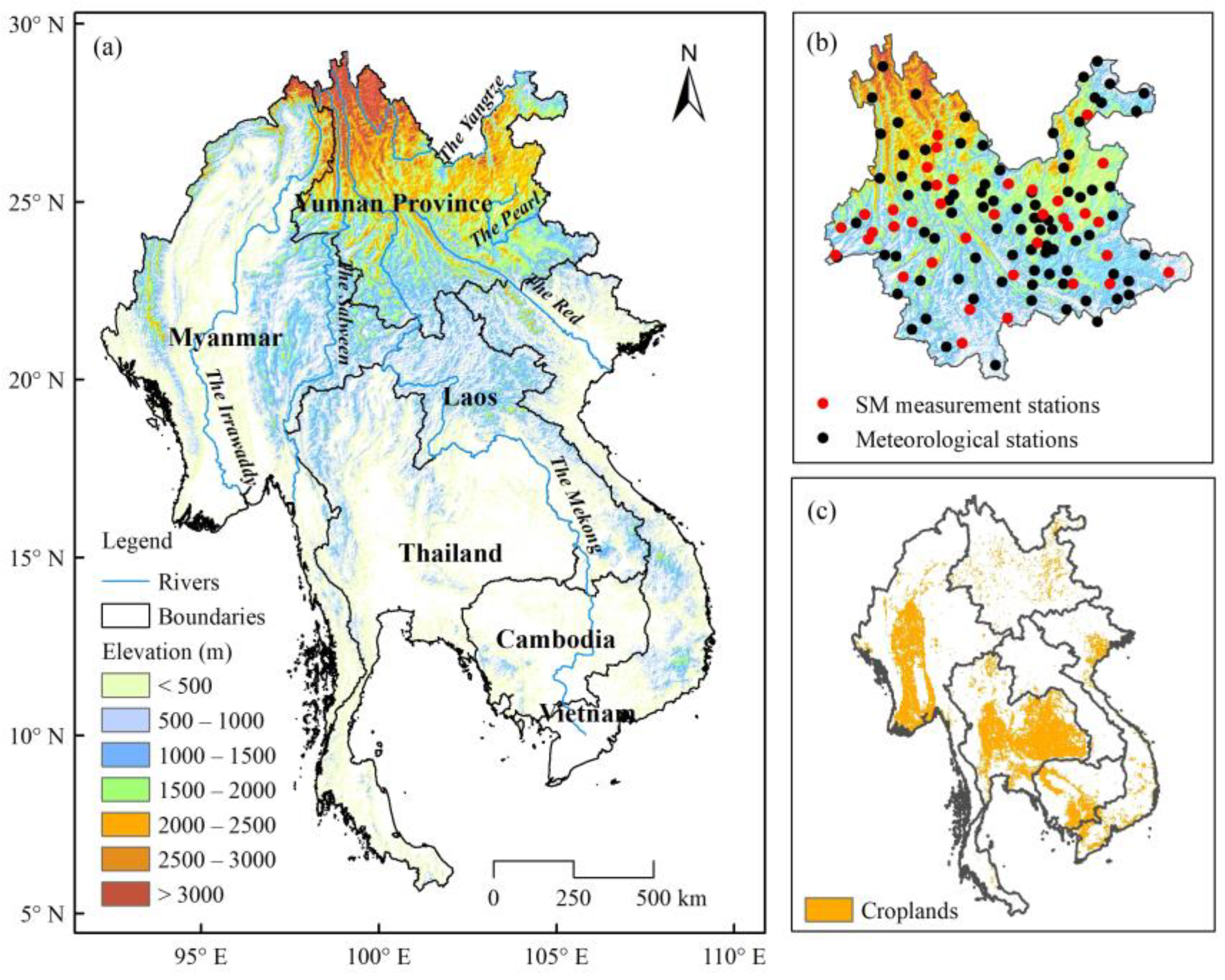
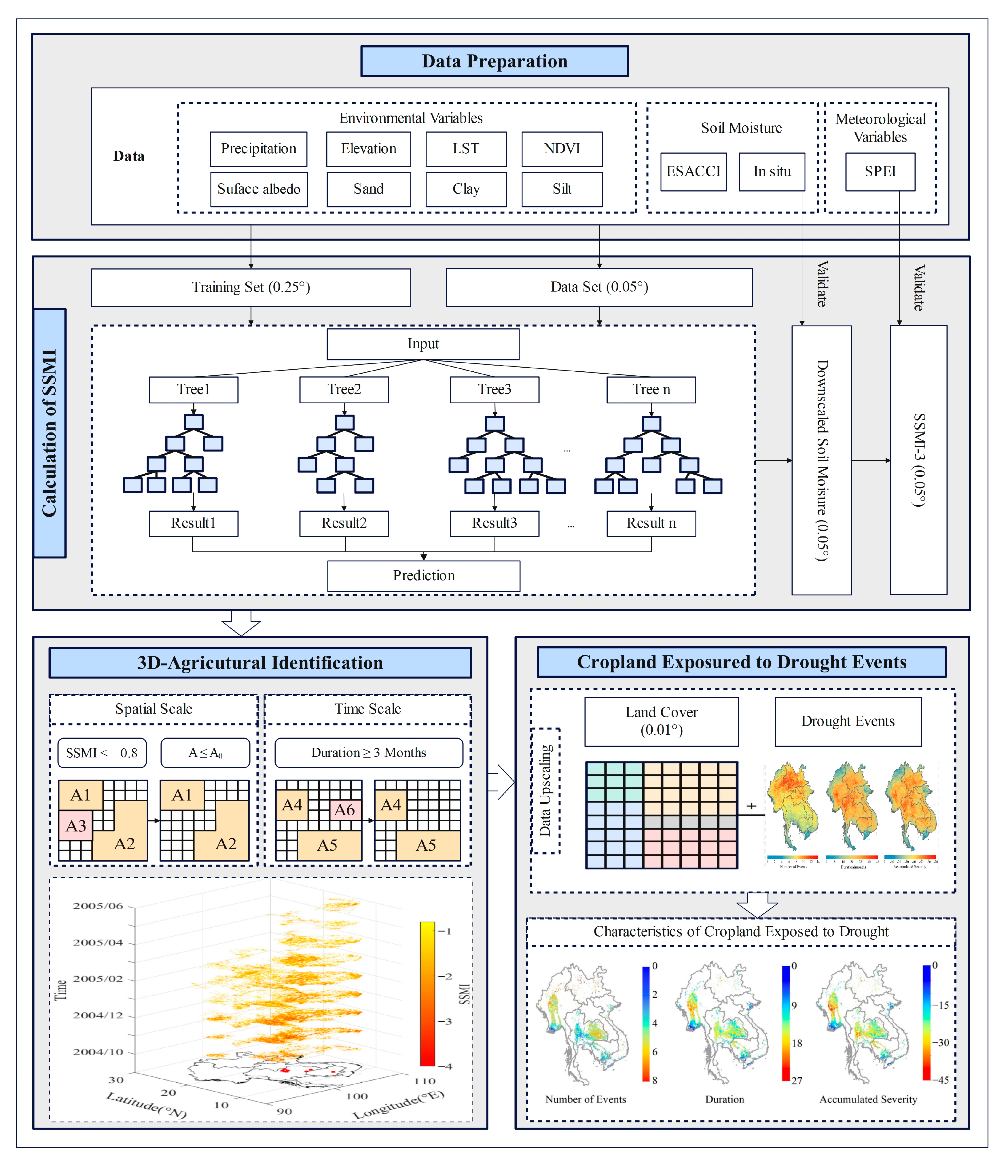
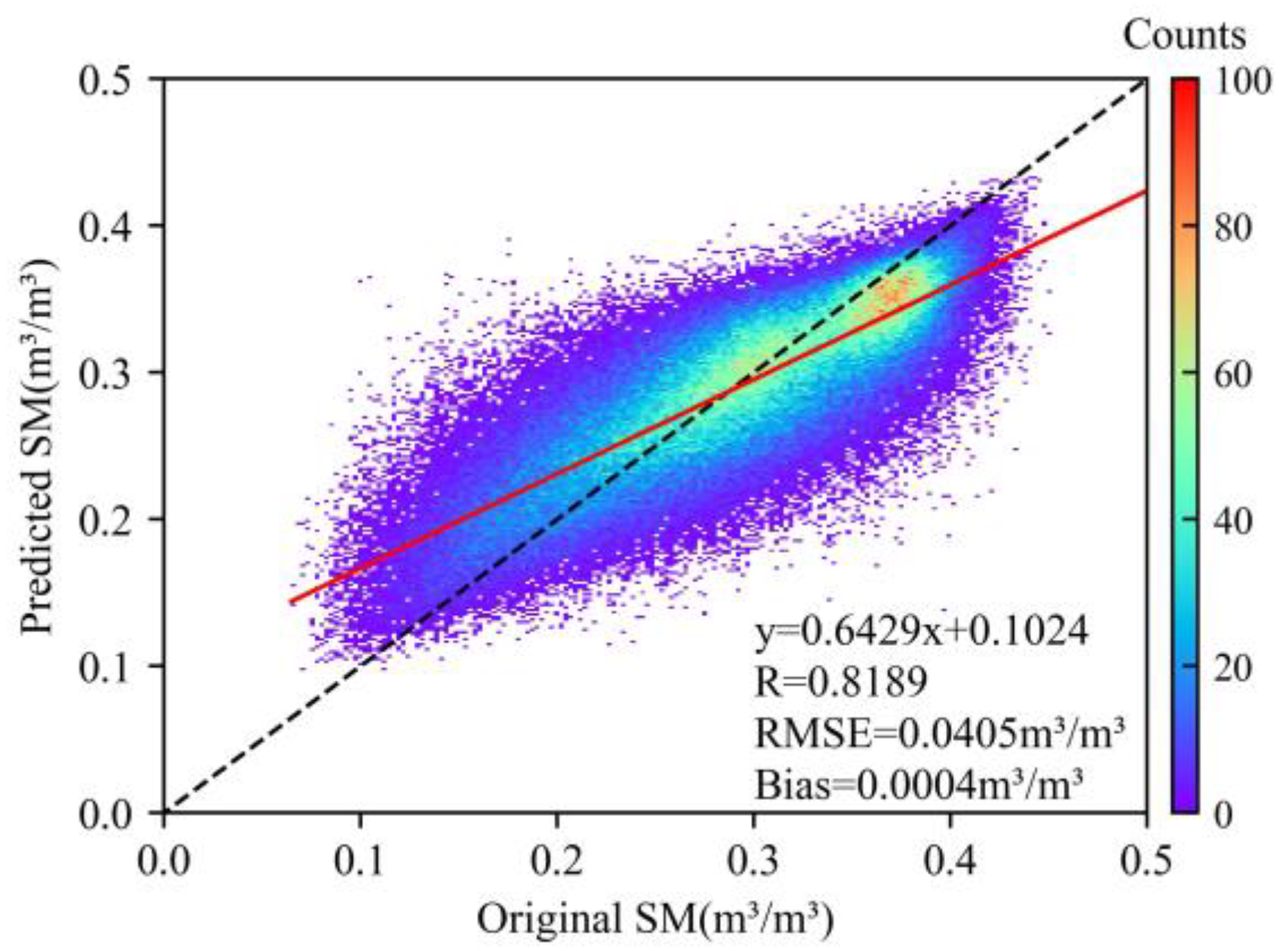
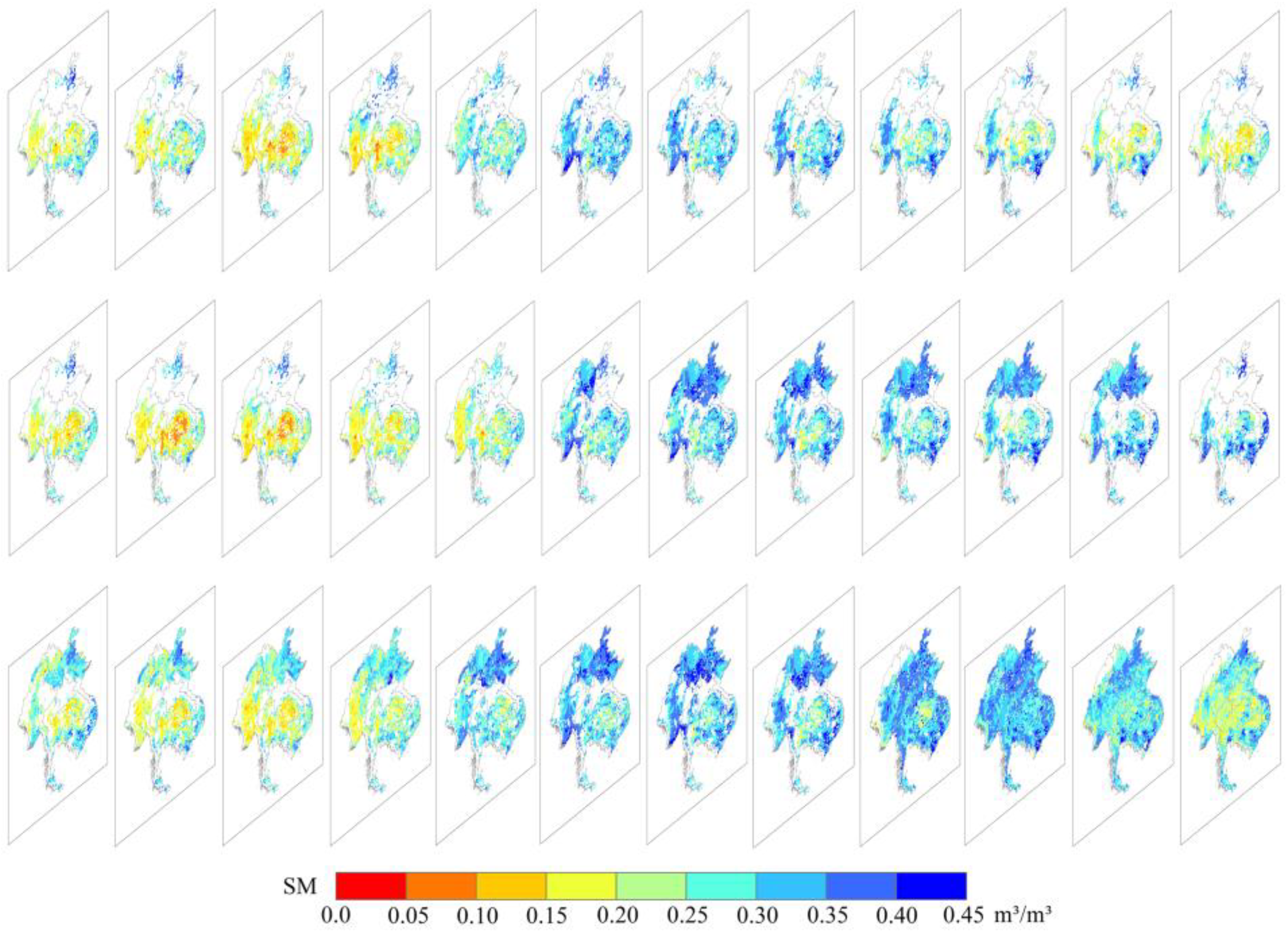
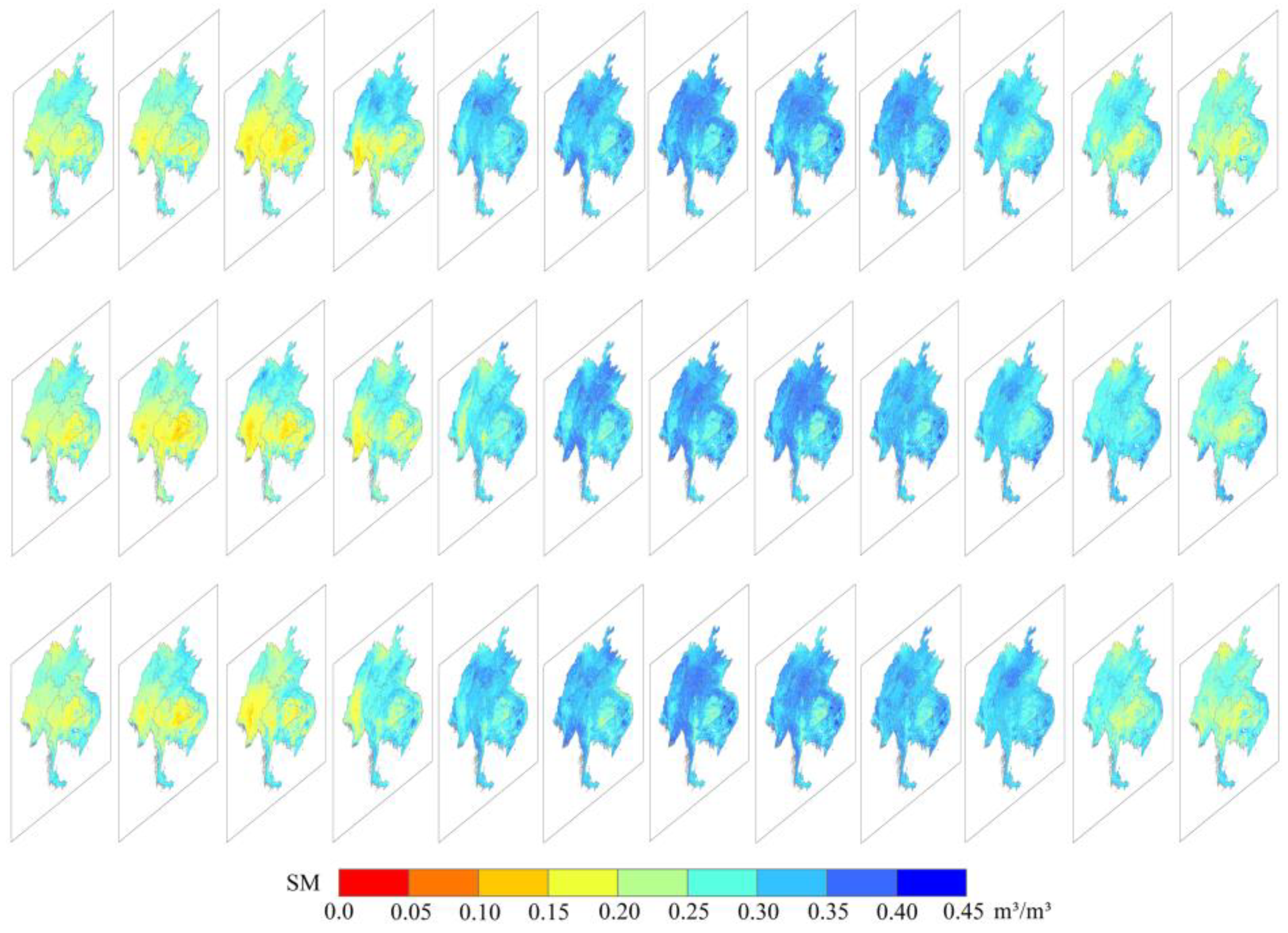
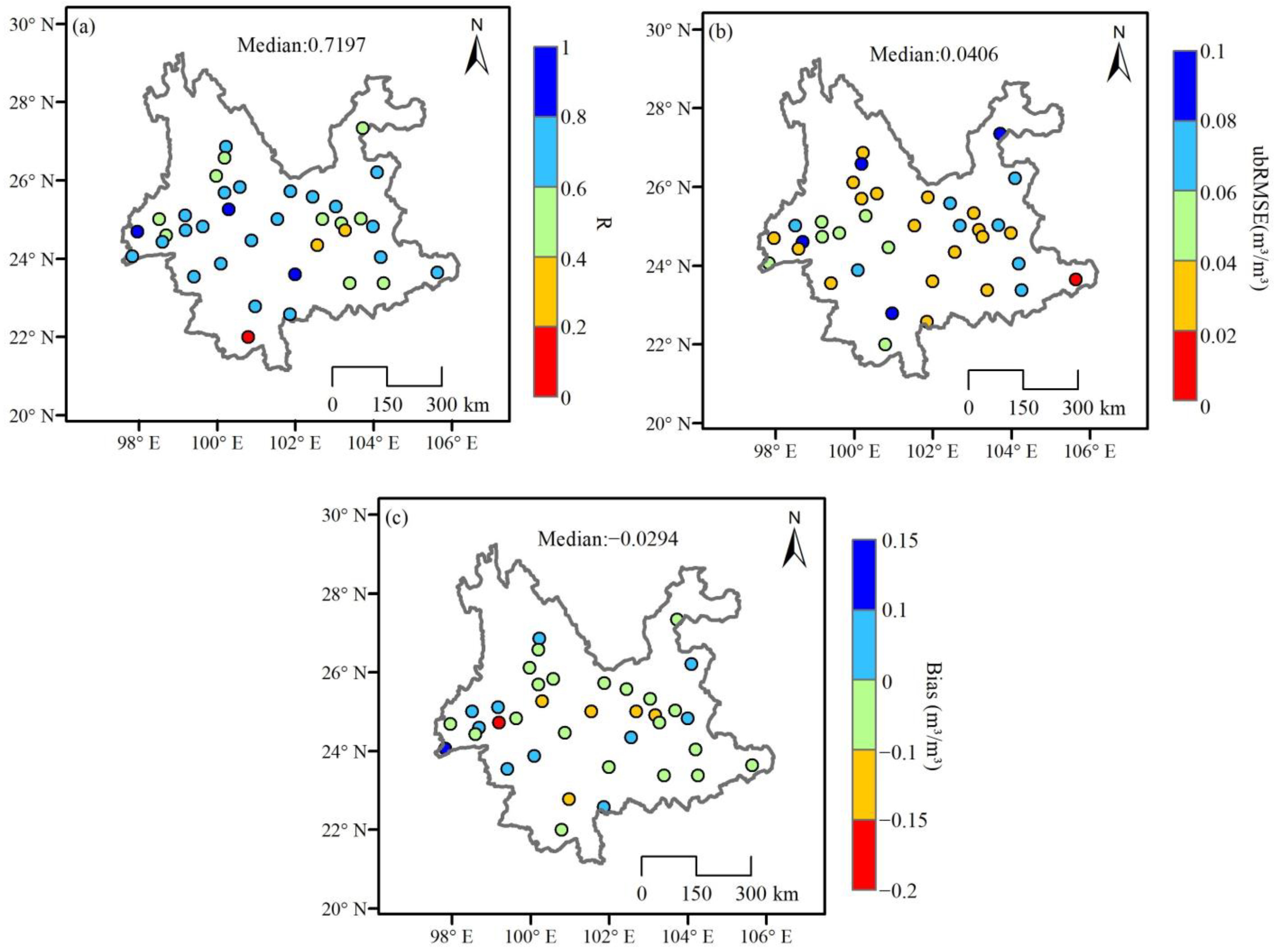
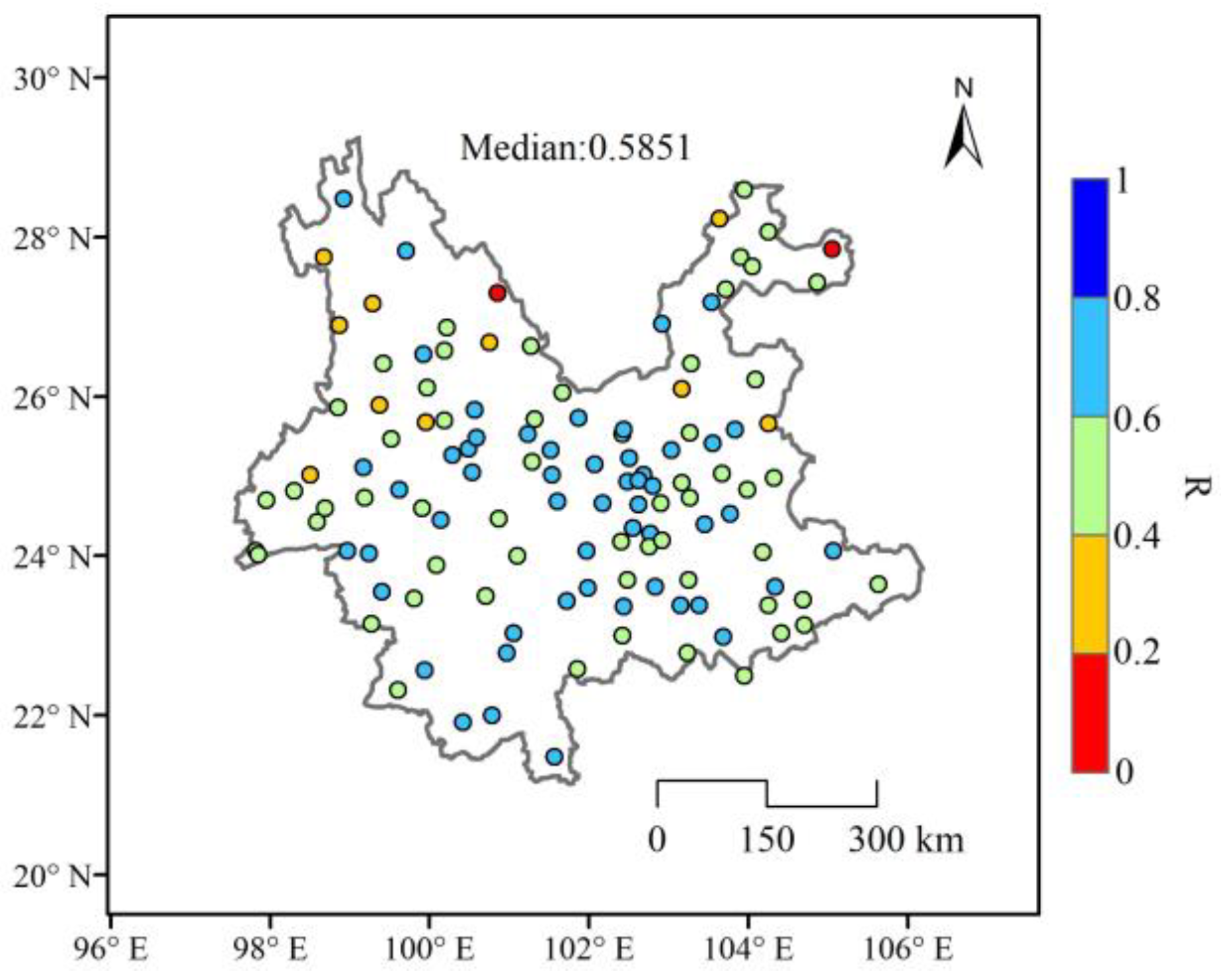
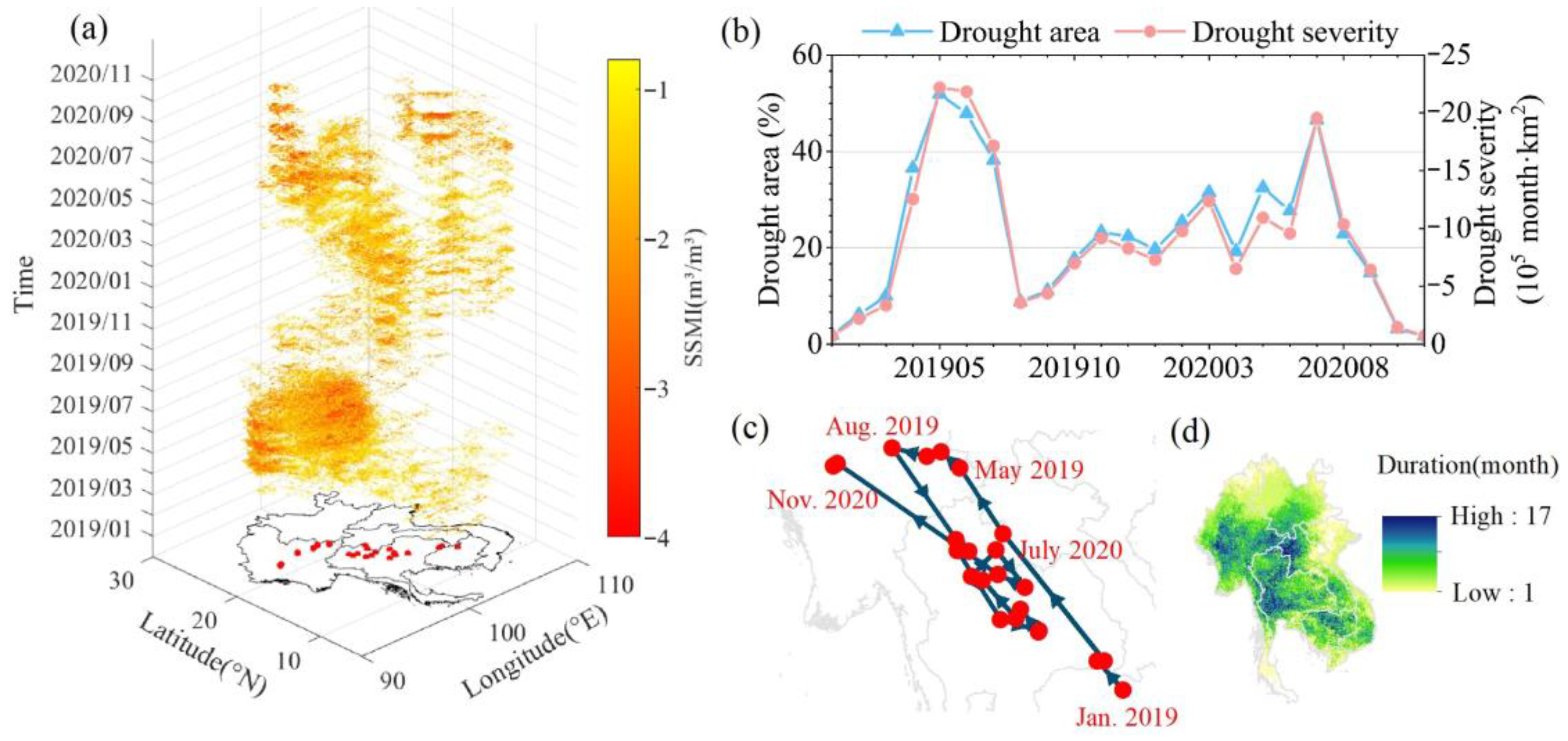
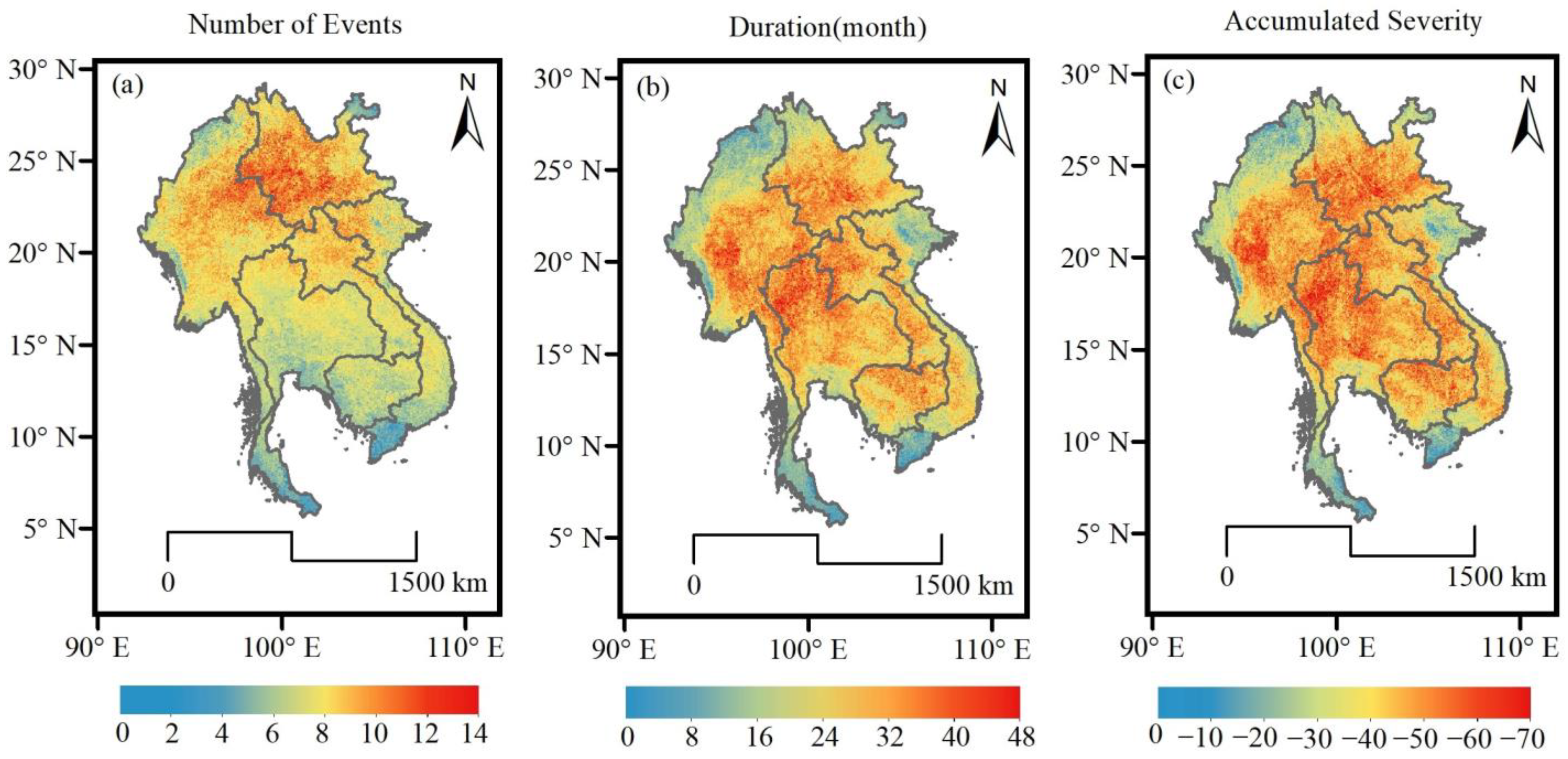
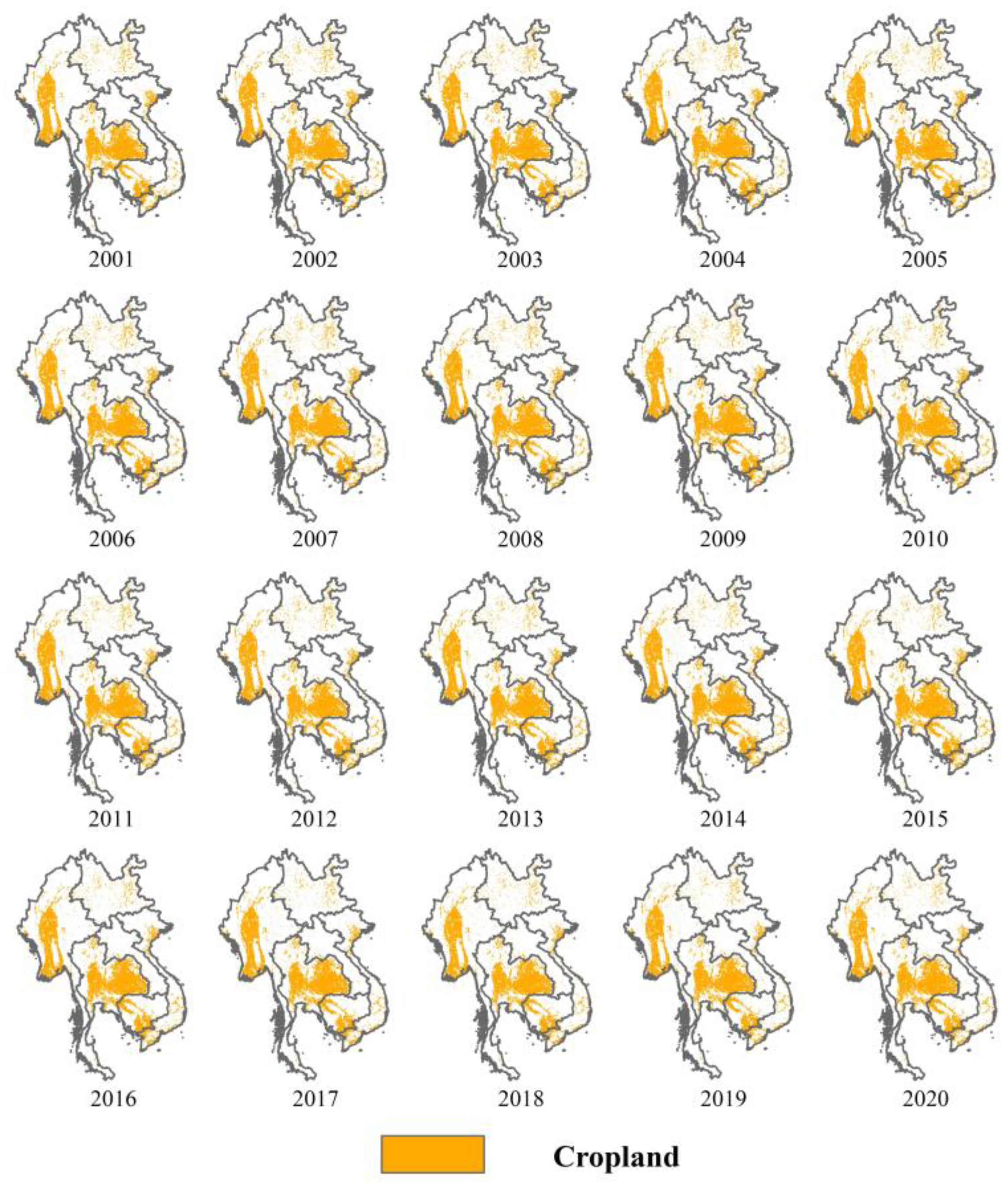
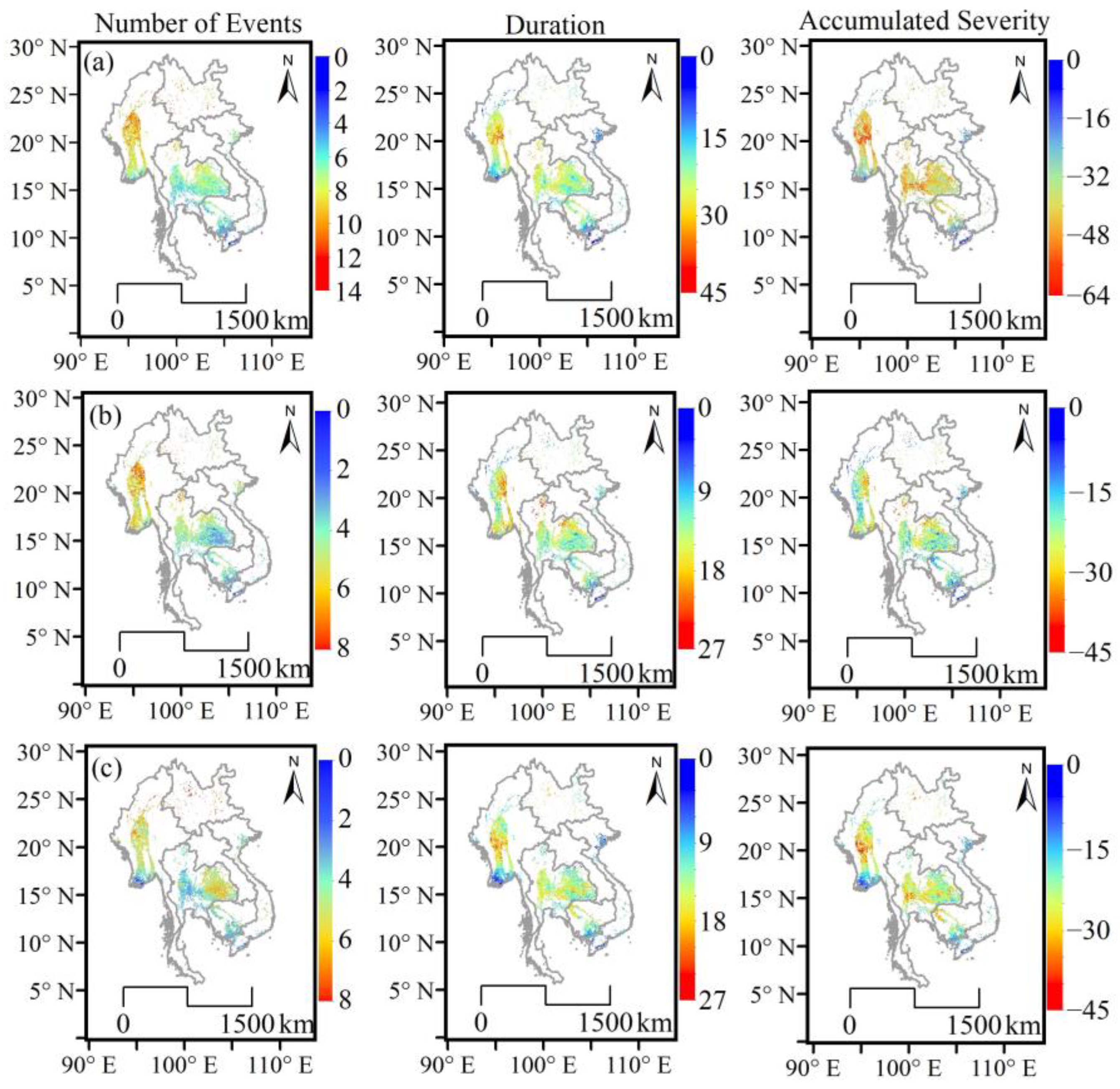
| Index | Datasets | Resolution | Source |
|---|---|---|---|
| Surface SM | ESACCI | 0.25°, daily | https://www.esa-soilmoisture-cci.org/, accessed on 9 October 2021 |
| Surface SM | In situ | Point, hourly | Yunnan Meteorological Service |
| Surface albedo | MOD09A1 | 500 m, 8-day | https://search.earthdata.nasa.gov/, accessed on 9 October 2021 |
| LST | MOD11A2 | 1 km, 8-day | https://search.earthdata.nasa.gov/, accessed on 9 October 2021 |
| NDVI | MOD13A3 | 1 km, monthly | https://search.earthdata.nasa.gov/, accessed on 9 October 2021 |
| Land cover type | MCD12Q1 | 500 m, yearly | https://search.earthdata.nasa.gov/, accessed on 9 October 2021 |
| Precipitation | CHIRPS | 0.05°, monthly | https://data.chc.ucsb.edu/products/, accessed on 22 January 2021 |
| Elevation | SRTM | 90 m, – | https://srtm.csi.cgiar.org/, accessed on 11 September 2021 |
| Percent of clay, sand, and silt | HWSD | 30″, – | https://www.fao.org/soilsportal/, accessed on 9 October 2021 |
| Precipitation, temperature, relative humidity, wind speed, and sunshine duration | Meteorological data | Point, daily | Yunnan Meteorological Service |
| Drought Event Number | Duration (Months) | Beginning Time (Year/Month) | Ending Time (Year/Month) | Drought Center | Drought Area (105 km2) | Drought Severity (105·Month·km2) | ||
|---|---|---|---|---|---|---|---|---|
| Time (Year/Month) | Longitude (°E) | Latitude (°N) | ||||||
| 1 | 3 | 2001/03 | 2001/05 | 2001/04 | 97.69 | 23.68 | 5.87 | −10.05 |
| 2 | 3 | 2002/04 | 2002/06 | 2002/05 | 99.79 | 19.10 | 2.67 | −4.62 |
| 3 | 3 | 2002/09 | 2002/11 | 2002/10 | 98.60 | 23.28 | 1.95 | −5.01 |
| 4 | 10 | 2003/07 | 2004/04 | 2003/11 | 100.14 | 19.61 | 15.95 | −66.74 |
| 5 | 9 | 2004/10 | 2005/06 | 2005/02 | 102.09 | 16.57 | 19.40 | −118.60 |
| 6 | 3 | 2005/05 | 2005/07 | 2005/06 | 99.15 | 23.63 | 6.95 | −16.22 |
| 7 | 5 | 2006/11 | 2007/03 | 2007/01 | 102.22 | 18.02 | 9.28 | −24.51 |
| 8 | 4 | 2009/01 | 2009/04 | 2009/02 | 100.19 | 22.25 | 8.87 | −19.35 |
| 9 | 12 | 2009/09 | 2010/08 | 2010/02 | 101.25 | 19.79 | 21.16 | −126.42 |
| 10 | 5 | 2011/06 | 2011/10 | 2011/08 | 103.41 | 25.16 | 2.67 | −13.02 |
| 11 | 6 | 2011/10 | 2012/03 | 2011/12 | 97.92 | 25.34 | 4.32 | −11.45 |
| 12 | 4 | 2012/03 | 2012/06 | 2012/04 | 101.61 | 23.97 | 5.02 | −10.34 |
| 13 | 10 | 2012/10 | 2013/07 | 2013/02 | 99.88 | 21.44 | 15.54 | −57.32 |
| 14 | 3 | 2012/11 | 2013/01 | 2012/12 | 105.59 | 14.74 | 2.60 | −5.17 |
| 15 | 3 | 2014/02 | 2014/04 | 2014/03 | 100.62 | 12.46 | 2.10 | −4.74 |
| 16 | 6 | 2014/02 | 2014/07 | 2014/04 | 100.19 | 22.82 | 10.16 | −30.83 |
| 17 | 6 | 2014/09 | 2015/02 | 2014/11 | 96.58 | 22.94 | 5.40 | −20.64 |
| 18 | 17 | 2015/04 | 2016/08 | 2015/12 | 102.62 | 16.40 | 20.97 | −150.72 |
| 19 | 3 | 2018/10 | 2018/12 | 2018/11 | 105.76 | 15.04 | 2.74 | −8.08 |
| 20 | 23 | 2019/01 | 2020/11 | 2019/12 | 100.64 | 18.54 | 23.24 | −207.44 |
| Drought Event Number | Total Cropland (105 km2) | Cropland Exposed to Drought (105 km2) | Percentage | Drought Event Number | Total Cropland (105 km2) | Cropland Exposed to Drought (105 km2) | Percentage |
|---|---|---|---|---|---|---|---|
| 1 | 4.85 | 0.83 | 17.18 | 11 | 4.97 | 0.25 | 4.96 |
| 2 | 4.90 | 0.60 | 12.29 | 12 | 4.97 | 0.25 | 5.08 |
| 3 | 4.90 | 0.07 | 1.40 | 13 | 5.01 | 3.22 | 64.19 |
| 4 | 4.96 | 3.34 | 67.21 | 14 | 4.97 | 0.94 | 18.84 |
| 5 | 5.02 | 4.41 | 87.95 | 15 | 5.04 | 0.11 | 2.19 |
| 6 | 5.02 | 1.05 | 20.87 | 16 | 5.04 | 0.82 | 16.21 |
| 7 | 5.00 | 1.65 | 33.02 | 17 | 5.04 | 1.13 | 22.35 |
| 8 | 4.99 | 1.09 | 21.91 | 18 | 5.06 | 4.59 | 90.66 |
| 9 | 5.01 | 4.43 | 88.52 | 19 | 4.85 | 0.58 | 11.89 |
| 10 | 4.97 | 0.19 | 3.80 | 20 | 4.85 | 4.72 | 97.30 |
Disclaimer/Publisher’s Note: The statements, opinions and data contained in all publications are solely those of the individual author(s) and contributor(s) and not of MDPI and/or the editor(s). MDPI and/or the editor(s) disclaim responsibility for any injury to people or property resulting from any ideas, methods, instructions or products referred to in the content. |
© 2023 by the authors. Licensee MDPI, Basel, Switzerland. This article is an open access article distributed under the terms and conditions of the Creative Commons Attribution (CC BY) license (https://creativecommons.org/licenses/by/4.0/).
Share and Cite
Ming, W.; Luo, X.; Luo, X.; Long, Y.; Xiao, X.; Ji, X.; Li, Y. Quantitative Assessment of Cropland Exposure to Agricultural Drought in the Greater Mekong Subregion. Remote Sens. 2023, 15, 2737. https://doi.org/10.3390/rs15112737
Ming W, Luo X, Luo X, Long Y, Xiao X, Ji X, Li Y. Quantitative Assessment of Cropland Exposure to Agricultural Drought in the Greater Mekong Subregion. Remote Sensing. 2023; 15(11):2737. https://doi.org/10.3390/rs15112737
Chicago/Turabian StyleMing, Wenting, Xian Luo, Xuan Luo, Yunshu Long, Xin Xiao, Xuan Ji, and Yungang Li. 2023. "Quantitative Assessment of Cropland Exposure to Agricultural Drought in the Greater Mekong Subregion" Remote Sensing 15, no. 11: 2737. https://doi.org/10.3390/rs15112737
APA StyleMing, W., Luo, X., Luo, X., Long, Y., Xiao, X., Ji, X., & Li, Y. (2023). Quantitative Assessment of Cropland Exposure to Agricultural Drought in the Greater Mekong Subregion. Remote Sensing, 15(11), 2737. https://doi.org/10.3390/rs15112737









